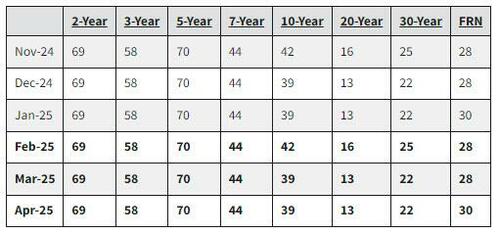Treasury To Keep Debt Sales Unchanged For „Next Several Quarters”, Prepares To Drop Issuance Forward Guidance
In the first refunding announcement under Trump’s new Treasury Secretary Scott Bessent, the US Treasury unveiled that it will keep sales of longer-term debt unchanged well into 2025, despite Bessent’s criticism of Janet Yellen’s issuance strategy before he was picked for the job.
Just two weeks into the most important job at the US Treasury, Bessent left intact former Secretary Janet Yellen’s agenda. As widely expect, the Treasury will next week sell $125 billion of debt in its quarterly refunding auctions, which span 3-, 10- and 30-year maturities, the same amount as in the past several quarters. The gross issuance will refund $106.2 billion of privately-held Treasury notes and bonds maturing on February 15, 2025, and will raise new cash from private investors of approximately $18.8 billion. The securities are:
- A 3-year note in the amount of $58 billion, maturing February 15, 2028;
- A 10-year note in the amount of $42 billion, maturing February 15, 2035;
- A 30-year bond in the amount of $25 billion, maturing February 15, 2055.
The table below presents the auction sizes for the November 2024 to January 2025 quarter and the anticipated auction sizes for the February to April 2025 quarter:

In its refunding statement, the Treasury said that it believes „its current auction sizes leave it well positioned to address potential changes to the fiscal outlook and to the pace and duration of future SOMA redemptions.” It added that based on current projected borrowing needs, „Treasury anticipates maintaining nominal coupon and FRN auction sizes for at least the next several quarters.”
Similar language has been in place since the last bump up in auction sizes at the start of last year. Bessent, a former hedge fund manager, had accurately charged Yellen of engaging in so-called Activist Treasury Issuance – holding down longer-dated debt sales in order to depress long-term borrowing costs and aid the economy before the election. Of course, he was right. Alas, reversing Yellen’s catastrophic policies can’t and won’t happen overnight absent a meltdown in the bond market, hence why the issuance schedule is as it is.
The forward guidance was maintained even as the Treasury Borrowing Advisory Committee — a key panel of Wall Street advisers composed of dealers, fund managers and other market participants — issued a separate letter in which “uniformly encouraged Treasury to consider removing or modifying” the language at this meeting, and “Some members preferred dropping the language altogether to reflect the uncertain outlook, though the majority preferred moderating the language at this meeting.”
However, the reason why there was no change – yet – is that the committee felt that any shift in language shouldn’t be read to indicate an expected near-term increase in nominal coupon auction sizes, consistent with the TBAC recommended financing tables and Treasury’s aim to be regular and predictable. TBAC members also noted „elevated uncertainty regarding macroeconomic developments and the fiscal trajectory and observed that current primary dealer assumptions and issuance levels imply a $1.5T cumulative funding shortfall over the next three years.”
According to Bloomberg, a senior Treasury official told reporters, when asked about that guidance, that TBAC offers recommendations, but they are just that, and it’s the department that decides.
The Treasury also said it was keeping issuance of floating-rate debt unchanged, while continuing to nudge sales of some Treasury Inflation Protected Securities, or TIPS, higher. Over the coming three months, the Treasury said it plans to use bills — which mature in up to a year — to address any seasonal or unexpected variations in borrowing needs. With regard to TIPS, the Treasury detailed the following adjustments for the February-to-April period:
- Increase the April 5-year TIPS new issue to $25 billion
- Boost the March 10-year TIPS reopening by $1 billion, to $18 billion
- Maintain the size of the February 30-year TIPS new issue auction size at $9 billion
Separately, we remind readers that since the start of this year, the Treasury has been constrained by the federal debt limit, which kicked back in after being suspended in mid-2023. The department has begun to use extraordinary measures to keep from a debt-ceiling breach. That means that even as the US piles on about $1 trillion in new debt every 100 days, the public won’t see the actual balance until some time in July when the next debt ceiling deal is implemented, after much kicking and screaming by so-called conservatives, who fold – as they always do – when realizing there is no other option.
“Until the debt limit is suspended or increased, debt limit-related constraints will lead to greater-than-normal variability in benchmark bill issuance and significant usage” of cash management bills, the department said.
Another complication for the Treasury’s debt sales in coming months and quarters is uncertainty when the Federal Reserve will halt, or slow further, its steady reduction in holdings of Treasuries — currently running at up to $25 billion a month.
When the Fed does fully phase out its so-called quantitative tightening, it will reduce the amounts the Treasury needs to borrow from the public, a process which will coincide with the drainage of the Reverse Repo facility which has been aggressively used to fund the US government through Bill issuance.
As Bloomberg notes, dealers now see QT as ending in the summer, rather than spring, “slightly increasing the expected need for borrowing from the private sector in 2025,” TBAC reported to the Treasury. “Market participants viewed risks as skewed towards a later finish,” although factors including debt-limit dynamics may complicate the Fed’s assessment of whether there’s an “ample” magnitude of reserves in the system, TBAC said.
Finally, Wednesday’s statement also detailed a new schedule of buybacks for the early February through May. As the schedule indicates, the Treasury plans to conduct weekly liquidity support buybacks of up to $4 billion per operation in nominal coupon securities. Treasury also plans to resume cash management buybacks around the April 2025 tax date. Amounts purchased in cash management buybacks temper reductions to bill auction sizes that would otherwise occur over the same timeframe.
Tyler Durden
Wed, 02/05/2025 – 09:20














![Nowy komendant ostrowskiej policji. Przez lata służył w Ostrołęce [ZDJĘCIA]](https://www.eostroleka.pl/luba/dane/pliki/zdjecia/2025/288-206277.jpg)